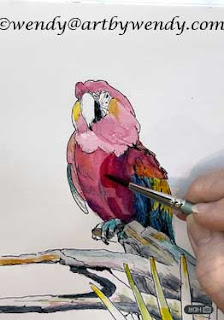Watercolours have SECRETS. Lots of Secrets. I discovered a Big one while on my painting trip to Ireland.
Ireland is green. I mean really green. It makes us here on the West Coast pale in comparison. So when it comes to painting in Ireland, you need to deal with 'all the green'. Light green, dark green, mauvy green, blue green, yellow green, golden green. . . Tons of different greens.
Hearing about all the greens of Ireland, I knew I was going to have a challenge for my Sketching on the trip. Before I had left on my trip I did introduce a new yellow (Quinophthalone Yellow - DS) and a new green (Green Apatite Genuine - DS) to my travel pallet. I was planning to make new mixes with them. The Green just didn't work at all. The yellow however opened up a new world for me.
That’s when I discovered the biggest secret of all.
********************
For further discussion and examples see my YouTube Video: 4 Ways to Mix Watercolours **********************
Mixing in the palette just doesn't always cut it. I like to use a premix green (Sap Green) in my outdoor pallet and then I push it towards a warm or cool colour by adding different colours to it. ie. adding Ultra Marine to Sap Green gives a nice blue green. You probably have your own recipes that that, too.

Sap Green and Quinophthalone Yellow with my Yellow underpainting
But here’s the Problem:

I took my cold yellow Quinophthalone Yellow, and mixed it with my soft green to get a nice lime green to put in the sunshine. That’s not good enough here in Ireland you need a variety of lime greens.
So I tried something new for me.
I took my cold yellow, and I did lots of under painting with it. Some of it quite heavy and some very lightly. I had started working with this before my trip but only in small sections. On my sample above, I started very dark and then slowly lightened up. Then let it dry.
While it was drying I mixed the green and yellow wet into wet. Letting each colour mingle and move. This is one of the more common ways of changing the colour.

Bottom line - Wet into Wet; Top line right, premixed yellow & green (light and dark)
Once the underpainting of yellow on my sample was dry, I glazed over it with my green. See Below. (Glazing is painting a thin layer of paint over a dry layer of paint.) Looking closely you can see having different values of yellow in the underpainting creates some very subtle variations in my lime green.
You are not limited to doing this only once. Glazing over the yellow with several layers of green also can vary the intensity of the resulting color. (You can glaze over a colour many times but be sure and make sure all the underlying layers are dry and only do light layers each time.)

Glazing the Green over the Yellow


I decided to take things one step further. I did an underpainting of the green and then glazed over it. See Below. 
Glazing Yellow over the Green

For each of the swatches I tried to have the darkest, strongest pigment on the left and get lighter as I moved to the right. When you study the samples you can see very subtle differences in turns of value and hue. But when you see the results in a picture it becomes very clear.
| My Iconic Ireland - Note all the different 'greens' |
As you study my little picture you can see how those subtle greens are soft, dark, warm and cold. The center midground and foreground have an underpainting of yellow. I used not only yellow and green glazes but also blue as a glaze over my greens.
******************** For further discussion and examples see my YouTube Video: 4 Ways to Mix Watercolours **********************
Glazing over a colour can create very subtle colour changes in your painting. It is certainly something you may want to spend more time on.
Taking Registrations for my Spring/Summer Events:
- Create Your Own Adventure - Let's go Outdoor Sketching 2.5 hr $85 Ind. Sm Group Rates $65ea Contact Wendy to set up a date. Location: Lower Mainland
- Sept 29, 6-8pm - Art Critique - Join me for a gentle critique on one of your paintings, is the perfect space for discussion, learning, and creative growth. FREE Registration Required - Langley Arts Council
- October 5, 9:30 -1pm - Make Friends with Your Pen - This playful workshop helps you loosen up, build trust in your lines and discover pen work can strengthen your overall drawing skills. Mission Arts Council: Register 604- 826-0029
- Save the Date: next set of 3 Zoom classes Thursdays, October 9, 16 & 23. Study of Shadows & Colour - Enhancing Your Drawing & Painting Skills. Early Bird: $75 after Oct 7, $90





































